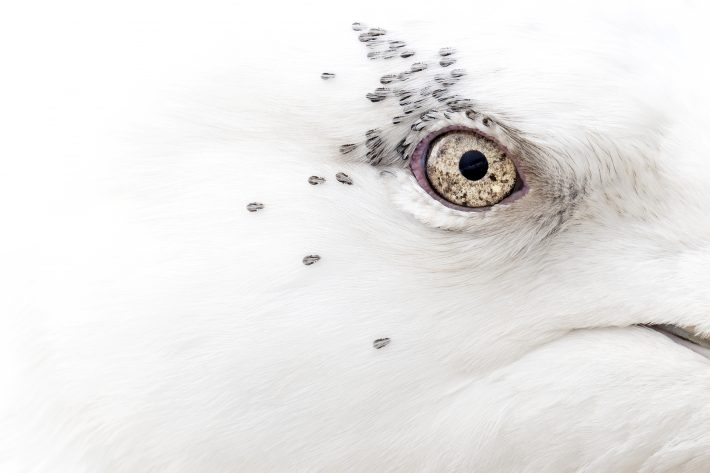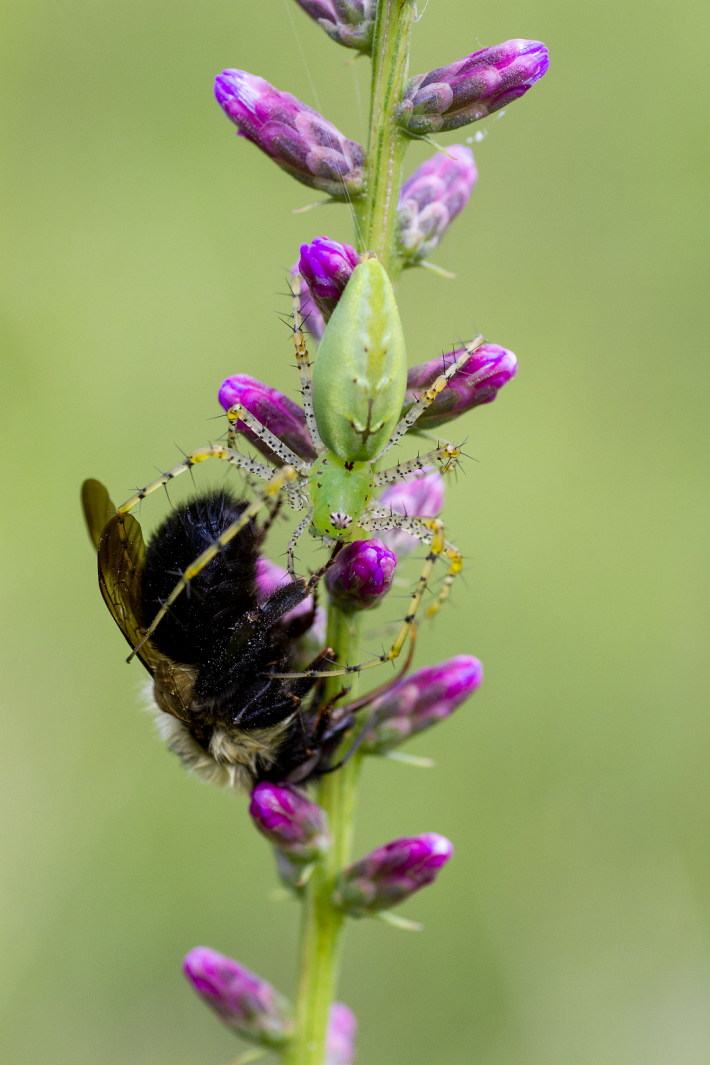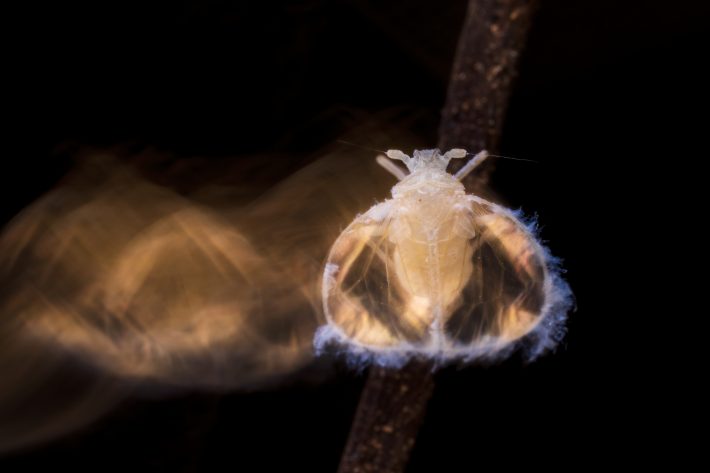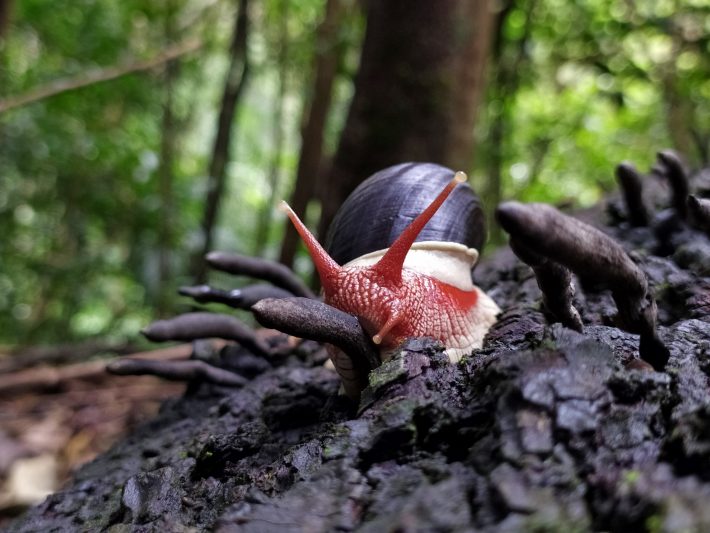
A close up of a Kumlien's Gull's eye, with speckled markings that aren't quite what they appear, taken by Rebecca Nason, has been awarded Overall Winner in the British Ecological Society's annual photography competition, 'Capturing Ecology'.
The winning images and an additional eight highly commended images, taken by international ecologists and students, celebrate the diversity of ecology, capturing flora and fauna from across the planet.
Subjects range from a blood red snail feeding on dead man's fingers (a fungus found in the rainforests of India) to a rare sighting of the 'fairy of the Valencian forests', a recently discovered cave-dwelling bug in Spain.
The winning images from this year's will be displayed in our immersive virtual exhibition, which is sponsored by Wiley. The exhibition will be made freely available to everyone when the embargo lifts.
Overall winner: Kumlien's Gull & Friends, Rebecca Nason:
On her winning image, Rebecca Nason – an ecologist and photographer living in Britain's most northerly harbour town of Lerwick, Shetland – said: "In April 2021, I came across a scarce Kumlien's Gull as I fed bread to a growing number of Herring Gull sheltering from a Spring storm. A beautiful gull, these birds breed in the Arctic regions of Canada & winter from Labrador west across the Great Lakes.
"When the Kumlien's gull approached to a good distance to allow for closer full frame shots. I started photographing the eye detail, noting a gorgeous granite coloured iris with dark speckled plumage detail around the eye. It was only when I got home I realised that the speckled patterns were in fact lice clustered around the eye, the Kumlien's Gull hadn't travelled alone!
"I am thrilled to win such a prestigious photography competition after entering for the first time this year. I have had a very symbiotic relationship between ecology work & bird photography in my career, so for both to come together in this way to win a competition with a gull image taken on my local patch, is just the icing on the cake."

Overall student winner: Hidden Lynx, Dani Davis:
The overall student winner is Dani Davis, a graduate student at Florida State University. Dani's image captures a green lynx spider with its bumblebee catch in the Apalachicola National Forest, North Florida. Green lynx spiders can change colours to match their background plant, a trait which they use when lying in wait for visiting pollinators. When their prey comes close, they pounce, like their namesake cat.
Dani Davis said: "Green lynx spiders are majestic yet voracious predators. Able to take down relatively large prey. With a quick bite, the lynx can subdue their cumbersome prey and feast in peace. Despite hearing of their ferocity, I was amazed to see this lynx with a bumblebee that matched her in size!
"A culmination of experiences in the field surrounded by incredible photographers and naturalists taught me how to tell natural history stories through images. With enormous thanks to those who spent time outside with me, I'm honoured to be the overall student winner for Capturing Ecology."

Professor Jane Memmott, President of the British Ecological Society, said:
"This year's photos are of a very high standard and are a pleasure to look through. Overall, the photographs capture a broad swath of biodiversity – from tiny mosses to giant bears. The winner is a beautifully composed photograph of a gull's eye – it's visually arresting, pin sharp and very beautiful, hitchhiking lice included!"
Competition judge, Laura Dyer:
The independent judging panel included six highly respected photographers including eminent ecologists and award-winning wildlife photographers. Among them was Laura Dyer, a South African born wildlife photographer, who has an affinity for animal portraits.
Laura said: "Wildlife and nature photography is so vital today, as it helps to showcase parts of the natural world which would otherwise remain hidden from the view of most of us. And it is only by seeing the beauty of nature that we will be inspired to protect and conserve it. These images from British Ecological Society members and students alike help to showcase these wonders.
"The three overall winners this year demonstrate completely different styles of photography and all so beautifully captured. The spider, which at first glance, is almost unnoticeable in 'Hidden Lynx' – you can imagine the surprise of the bumblebee as he met his end. The detail in the gull, and how at first glance the parasites appear to be feather markings. The delicate lighting and dancing nature of the image of the recently discovered 'Fairy of the Forest'. These are worthy winners."

Full list of winners:
Overall winner: Rebecca Nason
Kumlien's Gull & Friends: When taking full frame pictures of a Kumlien's gull, the photographer noticed a dark speckled plumage detail around the eye. It was only when they got home they realised that the speckled patterns were in fact lice clustered around the eye, the Gull hadn't travelled alone.
Overall runner-up: Roberto Garcia Roa, University of Valencia
The fairy of the forests: One of the few images of Valenciolenda fadaforesta ("fairy of the Valencian forests"), a cave-dwelling bug recently discovered in a few Spanish caves. Wonderful evidence of the extraordinary biodiversity hidden in the dark of cave ecosystems.
Overall student winner: Dani Davis, Florida State University
Hidden Lynx: A green lynx spider (Peucetia viridans) rests on a budding Liatris with its bumblebee catch. Seen in a bog in the Apalachicola National Forest in North Florida, USA. Green lynx spiders are masters of disguise. Able to change colours to match their background plant, they wait for visiting pollinators and then pounce on their prey, like their namesake cat.
Category 1 - Up Close and Personal
An image displaying the intricacy of nature using close-up or macro photography.
Winner: Alicia Hayden, University of the West of England
Beautiful Bryophyte: With the colours of the sunset in the background, the whole scene of this moss growing on a wall in Cornwall looks like something from a tropical rainforest. It shows the extraordinary macro world all around us, and how there is beauty in the smallest of living things.
Student winner: Jack Marcus Smith, University of Cambridge
Beauty in the (Mini)Beast: The image is a high magnification portrait of a blowfly. The photpgrapher wanted to reveal the intricacy and beauty of what many consider a pest. The blowfly is perfect for illustrating complexity in miniature and here they have captured the elaborate nature of each individual microstructure.
Category 2 - Dynamic Ecosystems
Demonstrating interactions between different species within an ecosystem.
Winner: Vijay Karthick, Nature Conservation Foundation, India
It's finger lickin' good: Indrella ampulla, an endemic species of snail is an important soil invertebrate that breaks down organic matter in the rainforest floors of the Western Ghats mountain range in India. Here, its feeding on Xylaria sp. fungi, commonly known as dead man's fingers.
Student winner: Dani Davis, Florida State University
Quick Catch: A tiny Phidippus regius (Regal Jumping Spider) sits perched with a freshly caught Sulphur butterfly. Observed while visiting a bog near Sumatra, Florida. Jumping spiders abound in this habitat. The photographer stared with curiosity at this regal jumping spider doused in yellow scales, holding the butterfly it had just caught.
Category 3 - Individuals and Populations
A unique look at a species in its environment, either alone or as part of a population.
Winner: Roberto Garcia Roa, University of Valencia
Fleeting race: A large flock of gulls performed short but very quick flights to move around a field of rice during the first hours of the morning. The fog in the environment and the fast movements of each individual allowed me to capture this dynamic but also frozen image of such a chaotic situation.
Student winner: Alwin Hardenbol, University of Eastern Finland
Master of the reeds: Bearded Reedlings (Panurus biarmicus) are strongly connected to reedbeds. In wintertime, this species eats reed seeds as shown in this image. The photograph took this picture in Espoo, Finland, aiming to depict how the bird's weight bends the reed.
Category 4 - People and Nature
An interesting and original take on the relationships between people and nature.
Winner: Molly Dunn, Florence Institute of Design International
Tsunami, Dormant ivy vines reach across a roadside wall blackened at the bottom by car exhaust. The photograph was taken on a small, neighbourhood street in Florence, Italy in the early spring of 2021.
Student winner: John Benjamin Owens, Bangor University/Captive & Field Herpetology Ltd.
Nature's Landmine, The Russell's viper (Daboia russelii) often resides within rice paddies. Accidentally stepped upon by agricultural workers, this viper is frequently involved in human-snake conflict, resulting in death and life changing injuries for millions of Indian people, annually. Something to think about when next buying rice in the supermarket?
Category 5 - Ecology in Action
Showcasing the practice of ecology in action
Winner: Pete Hudson, Penn State University
Bat OneHealth: While many of us are suffering with vaccines and regular swabs, the poor bats are also being sampled. At the start of the pandemic, our team were in Bangladesh sampling fruit bats near locations where Nipah virus had infected humans and recording virus and new viral sequences.
Student winner: Joshua Powell, Zoological Society of London, UCL & Seoul National University
Reintroduction in action: Conservation translocations - such as species reintroductions, or reinforcements - are increasingly important tools in conservation ecology. In South Korea, vets from the Korea National Park Service prepare to transport a female Asiatic black bear (Ursus thibetanus) in Jirisan National Park.
Category 6 - The Art of Ecology
A creative and original take on photography denoting ecology
Winner: Raul Costa-Pereira, The University of Campinas
Amazonian mosaic: In tropical rainforests, plants are often colonized by an astonishing diversity of organisms that grows on the surface of their leaves, such as epiphyllous mosses, lichens, and fungi. The photo shows the colourful mosaic of biodiversity on the leaves of an Amazonian palm tree in a forest near Manaus, Brazil.
Student winner: Alicia Hayden, University of the West of England
Spotlight: This spider was spending a lot of time repairing its web, and the streetlamp highlighted the movement of its legs as I took the photo. This illustrates the urban wildlife which is not usually acknowledged, showing the great diversity of wildlife in our urban spaces.






